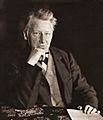Theoretical chemistry facts for kids
Theoretical chemistry is a field that uses mathematics and computers to understand how chemicals behave. It helps explain what happens in chemistry experiments. Scientists in this field try to predict how atoms join to form molecules. They also predict the special characteristics, or properties, of these molecules.
A big part of theoretical chemistry is quantum chemistry. This area uses quantum mechanics to figure out how many bonds an atom can make. Other important parts include studying how molecules move (called molecular dynamics) and understanding how heat and energy affect chemical systems.
Contents
Understanding Theoretical Chemistry
Theoretical chemists use many tools to do their work. They create mathematical models to guess how electrons act inside molecules. They also use computer calculations and simulations to test their ideas.
These scientists create theories and then predict things that experimental chemists can measure. This helps experimental chemists look for information that can prove a theory wrong. This information also helps them choose between different ideas.
If new information doesn't fit a theory, theoretical chemists try to change the theory a little bit. If a lot of new information doesn't fit over time, they might even stop using that theory.
Theoretical chemistry uses ideas from physics to explain or predict what we see in chemistry. Recently, it has focused a lot on quantum chemistry. This is about using quantum mechanics to solve problems in chemistry. The main parts of theoretical chemistry are understanding electron structures, how things move, and how statistics apply to chemical systems.
All these areas help predict how chemicals will react with each other. A lot of this work is called "computational chemistry". Computational chemistry often uses theoretical chemistry to solve real-world problems. For example, it can help guess chemical measurements using special computer methods. Some theoretical chemists use statistical mechanics to connect tiny quantum events to the bigger properties of chemicals we can see.
Main Areas of Study
Theoretical chemistry covers several key areas. Each area helps us understand different parts of the chemical world.
Quantum Chemistry
This area uses the rules of quantum mechanics to understand chemical problems. It helps explain how atoms and molecules behave at a very tiny level.
Computational Chemistry
This is about using computer programs to solve chemical problems. It helps scientists do complex calculations quickly.
Molecular Modeling
This involves creating computer models of molecular structures. It helps scientists see how molecules might fit together. Examples include molecular docking for drug design.
Molecular Dynamics
This area uses classical mechanics to simulate how atoms and molecules move. It helps scientists watch how molecules interact over time.
Molecular Mechanics
This focuses on modeling the forces between and within molecules. It helps predict how molecules will behave based on these forces.
Mathematical Chemistry
This area uses mathematics to describe and predict molecular structures. It does this without always using quantum mechanics.
Theoretical Chemical Kinetics
This is the study of how fast chemical reactions happen. It uses mathematical models to understand the pathways of reactions.
Cheminformatics
Also called chemoinformatics, this field uses computers and information science. It helps solve many different problems in chemistry.
Related Fields
Historically, theoretical chemistry has been closely linked to other scientific fields. These fields also study atoms and molecules.
Atomic Physics
This field studies electrons and the nuclei (centers) of atoms. It helps understand the basic building blocks of matter.
Molecular Physics
This area studies the electrons around molecular nuclei and how these nuclei move. It often looks at molecules with a few atoms in a gas.
Physical Chemistry and Chemical Physics
These fields use physical methods, like lasers, to study chemicals. Physical chemistry is a branch of chemistry, while chemical physics is a branch of physics. They are very similar.
Many-Body Theory
This theory looks at what happens in systems with many parts. It is based on quantum physics and helps understand complex interactions.
Images for kids
-
J. van 't Hoff (1852–1911), the first winner of the Nobel Prize in Chemistry, is widely considered one of the most brilliant theoretical chemists in history.
See also
 In Spanish: Química teórica para niños
In Spanish: Química teórica para niños


